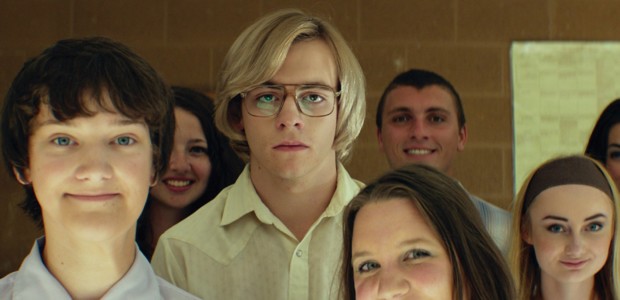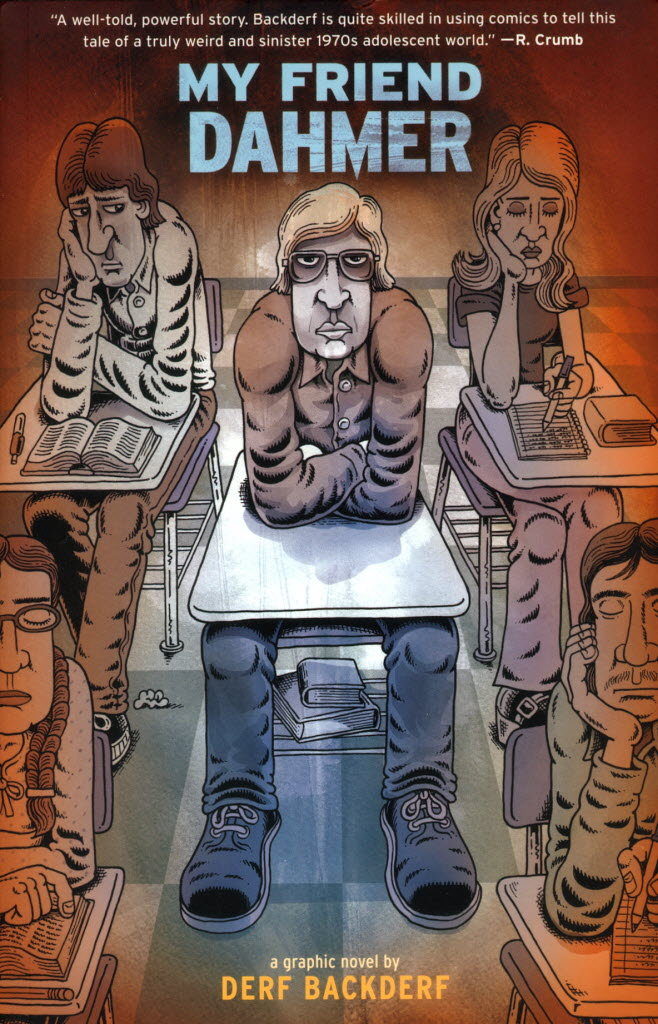MY FRIEND DAHMER, which played Fantastic Fest 2017 to great acclaim, was based on the graphic novel of the same name written by Derf Backderf. Through elaborate research, casting, and set design, director Marc Meyers was able to faithfully re-create the source material while putting his own unique stamp on the movie, depicting a monster who was once just a lonely and misunderstood teenager. Daily Grindhouse got the chance to talk to him about how he felt the young Dahmer was, what went into re-creating the seventies high school experience, and how he was able to create some empathy for someone eventually known for his many gruesome crimes.

Daily Grindhouse: What were the challenges of adapting the graphic novel into a film?
Marc Meyers: There were challenges all along the way, but that’s the nature of making an independent film. This is my fourth feature, and it always feels like a combination of sheer will and miracles that have to coalesce to turn the script into reality. During the script stage for My Friend Dahmer, there were many drafts to further distill the story. I always wanted to stay loyal to the spirit of the book, and capturing that takes time and trial & error. My producing partners Jody Girgenti and Adam Goldworm were critical during its development as we had to figure out many aspects of the adaptation — what to exclude like the use of voice-over, how we needed to condense the timeline, and where there was room for dramatic license — because we always felt the film version needed to portray Jeff’s home life in more detail than the book. But I always felt I was meant to make this movie, so I trusted my gut and made sure I had fun writing the script and dialogue. With our larger team of producers, convincing other people to get involved and finance the project was the longest challenge, as it often is. This is the story of Jeffrey Dahmer’s high school experience, essentially the story before the story we all knew. Not an easy sell necessarily. Once the script landed on the Black List, a wider group of talent agents were quick to introduce me to a whole slew of young talent. I met so many great young actors. Once I locked into and attached Ross Lynch, Alex Wolff, and Anne Heche to the project, it became easier for financing to also gather around the film. I was also determined to film in Akron, Ohio in & around where Jeffrey Dahmer actually grew up, including at his childhood home. This also led us to find many key collaborators & crew who are based in Ohio, which was great. They’re a very hardworking and committed, though small, community who often work together — and so I’m sure we avoided many local challenges by working with camera, production design, and costume departments who knew how to bring their local resources and relationships to the project. That said, it was an ambitious shooting schedule. We were constantly struggling to shoot all the scenes & set ups in our 21 day schedule, but I knew once we wrapped that I had the footage needed for the movie.
Daily Grindhouse: How did you manage to re-create so much of Dahmer’s persona that his friends thought it was creepy?
Marc Meyers: Casting was the most important step. First, taking my lead from the book, my script was designed to show all his peculiar tendencies and various forces playing upon Jeff’s teenage psyche. There’s his oddball behavior in school like throwing fake epileptic fits for everyone else’s amusement and how it attracted new friends, his audacity to attempt things other teenagers wouldn’t like cold calling the Vice President of United States, and how he discovered his own power of persuasion & charm, which we see when he asks Bridget to the prom. He is also handsome, which is an important part of his persona. And I knew I had to find an actor who looked the part and also had the versatility and charisma to make all these qualities — mixed with his private ghastly urges and depravity — his own. Also, his friends named their group the Dahmer Fan Club, and part of his high school persona was created by the friends who surrounded him and naively tried to elevate him to high school fame status. Jeff Dahmer was happy to receive the attention of others but as the dark proclivities start to peak through, and his alcoholism takes hold, his friends all start to see hints of the demons inside of Jeff and they drift apart.
Daily Grindhouse: How did you manage to capture the time era and set design so well?
Marc Meyers: Thank you. We were going for authenticity. Lots of credit goes to my production designer Jennifer Klide, costume designer Carla Shivener, and their dedicated, talented teams. We all were very simpatico. We all aimed to recreate the mid-to-late seventies era in the Midwest without exaggerating or adding some disco-flair to everything. During my early research I collected loads of photographs from the era — there’s a great collection from the National Archives found on Flickr — which I handed off to all of them. Of course, they simultaneously did their own research and individually remember growing up in the seventies; so for all of us, we felt like making the film was a personal expression of our youth. It’s quite miraculous what Carla’s team had to pull off in Week 1 — she had to dress all our main actors and so many extras for the high school hallways and classrooms, and I feel that no detail was overlooked. Production designer Jen Klide and her team also sourced high school desks and other furniture from an old school building in the city days before the building was to be demolished — and that was one of the small miracles that was a big win for us. Fortunately, at the last minute, our location department secured a high school in the Cleveland area that hadn’t changed much since the seventies. Those brown lockers and hallway tiles are a complete throw back to the era. By securing the Dahmer house very early in pre-production, it also set a standard that we were going to recreate this world as truthfully as possible. Jen and her team even rebuilt Jeff’s clubhouse on the actual spot where the real one once stood. Then, our transportation captain and prop master worked tirelessly to gather so many vehicles and items from the era. I knew we needed a clunker for Derf, and we found a beat-up AMC Gremlin that was perfect. Akron is also a car-town, and so there were a few car collectors in the area who willingly brought their old late-60s to late-70 vehicles to the set.
Daily Grindhouse: Did the film help you empathize with the character of Dahmer?
Marc Meyers: That’s in part our role as filmmakers with any & all characters — either hero or villain. Here I wanted to sculpt a story that showed all the forces at play both personally and swirling around him at school and home. We knew we were making a high school movie, and it just so happens that our main character would eventually become a monster. But for us, he was first & foremost a misunderstood teenager. And from the very beginning, I found ways to relate to Jeff as a teenager. My parents also divorced right after high school. Most teenagers feel misunderstood and confused, so I recalled that sensation. And Jeff wanted to make new friends and I remember friendship in high school, and the ways in which teenagers can be cruel to each other – often unknowingly — is something that we all experience in some form. But in no way was I looking to excuse the monster he would become.
Daily Grindhouse: What did you do to leave the character of Dahmer behind you when you were finished shooting?
Marc Meyers: I partied for a night. Then I slept. I definitely needed it. I went to a museum and Cleveland Indians game, but after I rested for a few days in Ohio, I packed up the van and headed back to New York. I was eager to join the edit. My producing partner & wife Jody Girgenti had returned home after wrap to pick up our daughter who was staying with her parents at the end of filming, so I was eager to get home too and get back to being a dad.
Daily Grindhouse: What prompted you to flash over some of the grislier aspects of the crime details in subtitles near the end of the film?
Marc Meyers: I feel it’s more lasting and powerful that the grisly aspects of his crimes are seared in your brain. I trust the power of the viewer’s own imagination to fill in the gaps. I wanted to create a story that opened with the image of the school bus roaring down the street, with Jeff Dahmer riding as a passenger, and end the film with Jeff as a driver. My whole story is contained within the opening and closing images. You can also look to Wikipedia and elsewhere on the internet for all those gruesome details.
Daily Grindhouse: Do you feel Dahmer’s friends in the film were real friends, or bullying him?
Marc Meyers: Both. What happened in the story is based on real events. Friends can be cruel at times, sometimes without even intending to or realizing it. And I’m paraphrasing — Jeffrey Dahmer once testified that high school was the best days of his life.
Daily Grindhouse: With some of the more charismatic aspects of his character, could you have seen Dahmer’s life taking a different route?
Marc Meyers: Possibly. It’s not my role to comment on the real Jeffrey Dahmer. MY FRIEND DAHMER is a cautionary tale. You witness how friends, family, and community all miss the signs. But if the doors to help him as a troubled, misunderstood teenager had stayed open, and known how to recognize he was disturbed, maybe he could’ve found help early… and that could’ve prevented some level of his crimes. That said, I believe, Jeff Dahmer was wired wrong from the beginning. I’m not a psychiatrist, just a dramatist and storyteller.
Daily Grindhouse: Do you feel the era Dahmer grew up in, with more hands-off teaching and parenting, helped govern the course of his life?
Marc Meyers: Very much so. Dahmer is a function of his era. Remember, growing up in the seventies in Ohio was a very local life. There was no internet or cable news to widen your world. Teenagers spent many hours by themselves with their thoughts. The local radio station might be one of a few ways to tap into the larger teenage culture. So if you were lonely, you likely didn’t have the resources to change that. And if your parents were self-consumed or just outright busy, while they also didn’t foresee reason to overly supervise their kids, then teenagers were left to their own devices. And sometimes, like in Dahmer’s case, it led to a young man slipping away from his sanity, away from his connection to this world.
Daily Grindhouse: How did you manage to stay so faithful to the source material while putting your own unique stamp on it?
Marc Meyers: Thank you. I put my heart and soul into the making of this movie. And I remember high school as both a fun & cruel place. So it was loads of fun recreating this time & finding parallels in my life. Mixing the humor and hijinks of high school with the creepy undercurrent stemming from Jeff’s burgeoning depravity was always the intention. I must say that everyone involved in the film from production through post remembered high school in a similar way, and they all put their stamp on the film too. Above all, I’m especially proud of the performances. For me as a director to work with this great ensemble of actors and help them find the nuances and honesty in their characters is always my primary focus, so I’m thrilled they’re getting appreciated in their own right.
I always viewed Derf’s graphic novel as my bible, per se. I did lots of research about the era, but I never felt like it was a task. All aspects of the colorful seventies were a great treasure trove. The music. The cars. The costumes. There were so many details to think about. You know, early in the writing process I spent a few days with Derf and he gave me some extra insights and details surrounding his book, and I recorded those conversations and that helped me find a deeper road map into his seventies experience, and from there I could find ways to make it my own too. I’m forever grateful for the trust he put in me. His book is very personal for him, and it’s that kind of bold storytelling that I love. Maybe a bit weird to say — that Jeff Dahmer and his friends are bizarrely similar to the rest of us. There’s just a few critical qualities that distinguish him from the rest of us, and in the worst way.
And please click here to read Paul Freitag-Fey’s interview with cartoonist John “Derf” Backderf!
Tags: Derf Backderf, Interviews, Marc Meyers




No Comments